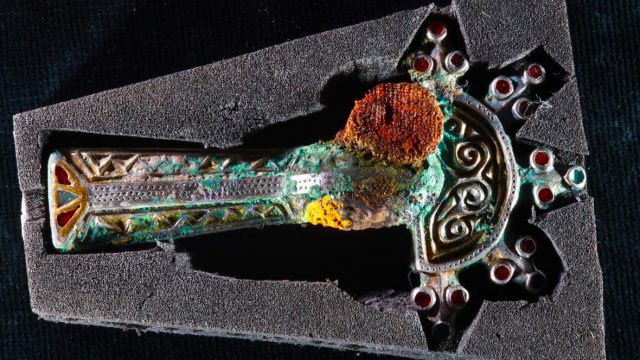In a stunning archaeological find in Saxony-Anhalt, near Brücken-Hackpfüffel, Germany, researchers have discovered a tomb dating back 1,500 years, thought to belong to a prominent Germanic lord or prince from the era of the Great Migration. This discovery, hailed as the most significant in Germany in the last forty years, uncovers a complex burial site featuring a central tomb, an enigmatic bronze cauldron, and the remains of six women who may have been sacrificed or selected to accompany the lord in death. This finding provides valuable insight into the burial customs and social structures of ancient Germanic tribes during a tumultuous time following the decline of the Roman Empire.
Unveiling the Tomb: A Royal Burial Site Discovered
The tomb was uncovered by chance when construction workers were clearing land for a new chicken farm. What they revealed was not just an ordinary site but rather a cemetery belonging to a royal court, concealed beneath the surface for centuries. Archaeologists were promptly summoned to investigate, and the location has since been kept confidential to guard against looting. While the discovery is remarkable, the specific remains of the prince believed to be interred there have not yet been identified.

The Enigmatic Bronze Cauldron and the Women Interred
At the center of the tomb lies a bronze cauldron, surrounded by the burial sites of six women arranged in a circular pattern reminiscent of clock hands. This layout suggests a potential ritual significance, leaving open the question of whether these women were sacrificed at burial or chose to offer their lives voluntarily. The cauldron, likely central to the tomb’s narrative, has been carefully extracted for further study, with speculation that it may hold the ashes of the prince himself.
A Noble Burial: Indicators of Social Hierarchy

The central tomb, along with the remains of eleven animals—including cattle, dogs, and horses—indicates the high rank of the individual interred within. Encircling this main chamber are approximately 60 additional graves, likely added later to honor the lord. These graves contain various artifacts such as a glass-decorated bowl, silver-gilded robe fasteners, a sword, and a gold coin from Eastern Roman Emperor Zeno, all of which reinforce the presence of a high-ranking Germanic tribe, possibly the Longobards, Alemanni, or Thuringians.
Immaculately Preserved: Natural Protection for the Site
The remarkable preservation of the burial site is attributed to its distinctive location in a natural depression that became gradually covered with sediment over time. This protective layer shielded it from agricultural activities and treasure hunters, allowing the graves and their contents to remain intact. The preservation of these artifacts offers a rare opportunity to explore the burial customs and material culture of Germanic tribes during the Great Migration period.
Revealing Historical Secrets: Ongoing Research
As archaeologists continue their analysis of the bones and artifacts uncovered, they aim to gain new understandings of life during this tumultuous historical period. The tomb’s unusual arrangement and wealth of grave goods present a unique opportunity to delve deeper into social hierarchies, burial practices, and cultural influences of that era.

Conclusion
The discovery of the Germanic lord’s tomb in Saxony-Anhalt marks a groundbreaking moment that provides an exceptional and detailed look into the lives of ancient Germanic tribes during the Great Migration. The enigma surrounding the central bronze cauldron and the sacrificial women enhances the intrigue of this find, prompting inquiries into the rituals and beliefs of that time. As researchers persist in studying this site, it is poised to offer fresh insights into a pivotal chapter in European history, where the vestiges of the Roman Empire transitioned into the emergence of new powers and cultural transformations.

